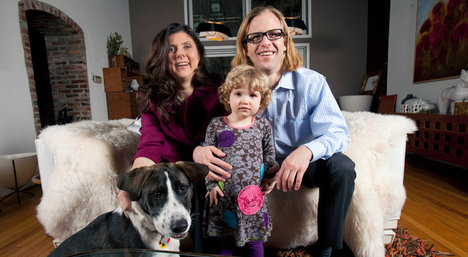 “Betsey Stevenson and Justin Wolfers are the go-to pair on what some might call “lovenomics,” having produced much research on marriage, divorce and child-rearing. They are shown at home with their daughter, Matilda, and family dog, Max.” Source of caption and photo: online version of the NYT article quoted and cited below.
“Betsey Stevenson and Justin Wolfers are the go-to pair on what some might call “lovenomics,” having produced much research on marriage, divorce and child-rearing. They are shown at home with their daughter, Matilda, and family dog, Max.” Source of caption and photo: online version of the NYT article quoted and cited below.
(p. 1) . . . when Ms. Stevenson, 40, and Mr. Wolfers, 39, start talking about say, diapers or nursing, the conversation takes an odd turn. Suddenly, words like “inputs” and “outputs” — the economic kind — creep in. Mention loading the dishwasher and he tosses out “fungibility.” The low cost of two big teddy bears they bought for Matilda gets Ms. Stevenson ruminating on productivity gains.
If they don’t quite sound like the rest of us, that’s because these two Harvard Ph.D.’s form a sort of power couple in the world of the dismal science, or at least a certain corner of it. Faculty members at the Wharton School of the University of Pennsylvania, and currently visiting fellows at Princeton, Ms. Stevenson and Mr. Wolfers have become the go-to pair on the economics of marriage, divorce and child-rearing. That they are themselves a couple — unmarried, for tax reasons they regularly cite — adds to the allure.
. . .
Their research shows that men have grown happier as women have become unhappier. (Why? They don’t really know.) Are people in rich countries happier than people in poor countries? (Yes.) And contrary to popular belief, they show that the divorce rate in America has been falling, not rising, for decades. They cite a number of possible reasons, including more balanced expectations between men and women about how a marriage will actually work, as well as the fact that fewer people are marrying in the first place.
. . .
(p. 4) LAST month, Ms. Stevenson and Mr. Wolfers presented new research into what is known as the Easterlin Paradox. First documented by the economist Richard Easterlin in the 1970s, this concept involves the link between economic growth and happiness. The idea is that, within a given country, people with higher incomes are more likely to be happy, and yet, for the most part, the average level of happiness doesn’t vary much from rich countries and poor countries. What’s more, as countries become richer, their populations don’t become happier.
Using a red laser pointer to highlight PowerPoint graphs, Ms. Stevenson told a group of economists, psychologists and other experts gathered at the Russell Sage Foundation on the Upper East Side of Manhattan that earlier research had failed to take into account that as people and countries grow richer, it takes a much bigger amount of absolute dollars to raise incomes, and thus happiness.
So while it could appear that increases in happiness flattened out after incomes reached a certain point, “the richer you are, the more dollars it takes to give you the same increase in well-being,” Ms. Stevenson said. “To get a 10 percent increase in income, you need more dollars than when you are poor.”
For the full story, see:
MOTOKO RICH. “It’s the Economy, Honey.” The New York Times, SundayBusiness Section (Sun., February 11, 2012): 1 & 4.
(Note: ellipses added.)
(Note: the online version of the review is dated February 11, 2012.)

